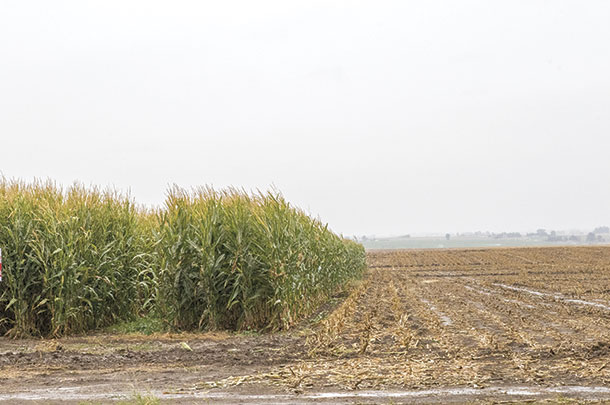In fact, some regions experienced the wettest October in the past 120 years. Extreme weather conditions can not only reduce yield but also delay harvest, increase plant stress and lead to future issues for the crop, including molds and mycotoxins.
Mycotoxins are a concern for livestock producers, as they influence feed quality and animal safety. They are produced by certain species of molds and can have toxic properties that impact animal health and performance, potentially resulting in economic loss for livestock producers.
Corn silage samples collected from across the U.S. have shown high levels of mycotoxins, particularly deoxynivalenol (DON), zearalenone, fumonisin and HT-2.
Mycotoxin risks
As the name implies, mycotoxins are toxic; they can negatively affect the health of animals if contaminated feedstuffs are ingested. The symptoms can be many and varied, but the outcome in all cases will be reduced performance and lost profits.
Produced by certain molds, more than 500 mycotoxins have been discovered to date, and each one affects the animal or human in a certain way.
For instance, some mycotoxins are carcinogenic, neurotoxic and immunosuppressive. They are seldom found in isolation and, when multiple mycotoxins are consumed, they may have additive – or even synergistic – interactions that increase the overall risk to performance and health.
It is important to note, once there are mycotoxins in the crop, they will not go away. Farms practicing monocropping of corn can expect to see higher levels of mycotoxins than farms that rotate crops or use deeper tillage methods.
Harvest analysis
Samples submitted to the Alltech 37-plus mycotoxin analytical services laboratory for the annual harvest analysis program from September to October 2018 included corn grain that contained mixtures of mycotoxins. An average of seven mycotoxins were found per sample (range 2 to 13), a stark increase from the average 3.9 mycotoxins per sample found in samples submitted over the same period from 2017.
Mycotoxins present include type B trichothecenes (DON group), type A trichothecenes (T2/HT2 toxins group), zearalenone, fusaric acid and fumonisin. Type B trichothecenes are currently averaging at just over 578 ppb (0.578 ppm) and being detected at up to 3,512 ppb (3.5 ppm).
Zearalenone has been detected in 26 percent of samples at an average of 125 ppb (max. 2,535 ppb), while type A trichothecenes have been detected in 31 percent of samples (average 26, max. 619 ppb) and fumonisins in 86 percent of samples (average 3,615, max. 14,004 ppb).
 Overall, the risk to beef cattle is higher (Alltech REQ = 145), although the inclusion rate in the ration could alter the final risk.
Overall, the risk to beef cattle is higher (Alltech REQ = 145), although the inclusion rate in the ration could alter the final risk.
Forages such as corn silage, barlage and haylage samples also contained multiple mycotoxins in 2017, including DON, fusaric acid, T-2 and fumonisin. In 2018, mycotoxins in U.S. corn silage are showing an increase in occurrence, with an average 6.8 mycotoxins per sample compared to the 4.6 on average during the same time period last year.
The 2018 average Type B trichothecenes (DON group) levels of 2,405 ppb (max. 17,113) are very similar to the 2017 average of 2,738 ppb (max. 19,849 ppb), along with a similar occurrence rate of 94 to 95 percent in samples. Of these samples, 36 percent were above 2,000 ppb (2 ppm), indicating a moderate risk or above for beef cattle, while 26 percent of corn silage samples were above 3,000 ppb (3 ppm) or higher-risk.
Despite the similarity between 2017 and 2018 harvests regarding type B trichothecenes, interestingly, the occurrence and concentrations of zearalenone have been greater in 2018 corn silage. Occurrence rate is at 16 percent (versus less than 1 percent in 2017) with an average of 144 ppb (max. 4,021 ppb), increased from the 2017 average of 12 ppb (max. 2,233 ppb).
Type A trichothecenes (T-2/HT-2 toxins group) have also been detected at a greater occurrence in 2018 corn silage at 43 percent (21 percent in 2017) with an average of 35 ppb (max 800 ppb). A total of 10 percent of corn silage samples were above 100 ppb, which is a moderate risk level for beef cattle. Fumonisins also remain a frequent co-contaminant.
Fusarium mycotoxins, such as type B trichothecenes, type A trichothecenes, zearalenone and fumonisins, can have a negative impact on feed intake, rumen functions, gut health, liver function, immune response and growth rate. Based on Alltech 37-plus analysis and risk assessment, 2018 corn silage samples are at a higher risk, on average, for beef cattle.
Effects of mycotoxins on ruminants
When cattle consume feed contaminated with mycotoxins, they can incur negative effects that result in long-term declines in performance and, ultimately, lower farm profitability. Chronic mycotoxin consumption, in which smaller quantities of contaminated feed are consumed over time, is often more challenging than an acute single dose, as the mycotoxin risk may not be noticed until a loss of production and health has already occurred.
Although the rumen micro-organisms can help degrade some mycotoxins, they may also convert other mycotoxins into more potent forms. Certain mycotoxins can pass through the rumen unchanged to be later absorbed in the small intestine, while other mycotoxins may have antibiotic-like effects directly on the beneficial rumen micro-organisms. As a result, the rumen and gastrointestinal tract are the main targets of mycotoxins in cows.
Based on the Fusarium mycotoxins (DON, zearalenone [ZEN], fusaric acid and T-2/HT-2 toxins) detected in this year’s grain and forage samples, cattle may show a multitude of symptoms, including changes to feeding behaviors, rumen disorders, lesions or hemorrhaging of the gastrointestinal tract, altered conception rates and increased disease occurrence.
Influencing conditions of mycotoxins
The occurrence and concentration of mycotoxins are influenced by many factors, including drought, excess rainfall, hot or cool temperatures, pests and agronomic practices.
In 2018, the U.S. experienced varying weather patterns depending on region. While some areas dealt with drought conditions, others saw extreme rainfall – the latter of which can promote the growth of Fusarium molds. Environmental conditions that stress plants and are ideal for mold growth could result in high levels of many mycotoxins, including DON, T-2/HT-2, ZEN, fusaric acid and storage-type mycotoxins.
Corn samples coming in from Nebraska are showing concentrations of type B trichothecenes and fumonisins higher than the U.S. average. This may be due to summer drought followed by late-season rains. However, corn samples across Iowa, Minnesota and South Dakota – where rain was more prevalent – show zearalenone to be more of a problem for cattle, along with the continued presence of type B and type A trichothecenes.
While weather is linked to the higher mycotoxin rates of recent years, other important factors are contributing to the scope of the findings, including better detection methods as well as increased awareness among farmers.
The ability to test for mycotoxins has been created through new technologies, and continual advancements will allow for more tests to identify more toxins. Different agronomic practices, such as tillage practices or the use of fungicides, may also have an influence.
Mycotoxins are a challenge to animal and feed production, and employing preventive measures for managing mycotoxins is essential to minimizing profit loss. Proper mycotoxin management techniques can reduce the risk of mycotoxins coming from feed materials and can also help prevent the negative effects that mycotoxins can have on livestock performance and health. For more information on mycotoxin management, visit online (Mycotoxins Management). ![]()
PHOTO 1: The Alltech 37-plus mycotoxin analytical services laboratory studies samples for the annual harvest analysis program. Photo courtesy of Alltech.
PHOTO 2: Extreme weather conditions can not only reduce yield but also delay harvest, increase plant stress and lead to future issues for the crop, including molds and mycotoxins. Staff photo.

-
Alexandra Weaver
- Mycotoxin Management
- Alltech
- Email Alexandra Weaver






